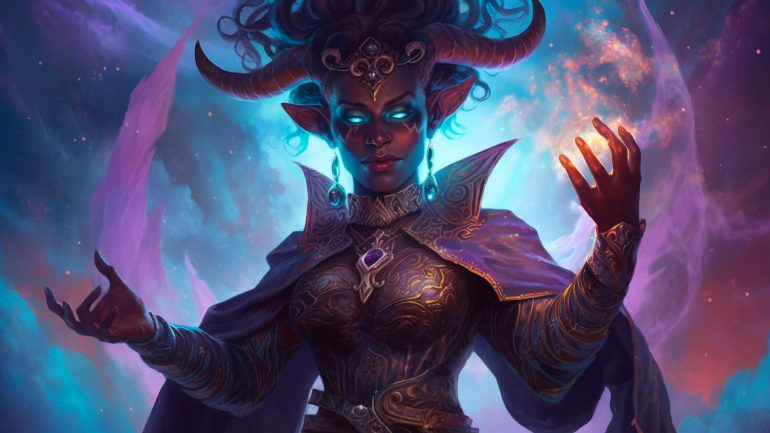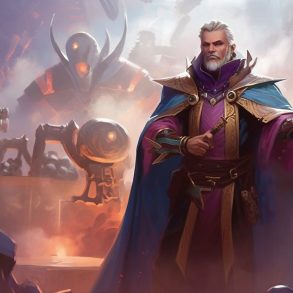A subclass that throws the normal tactics for playing a Sorcerer out the window, the Divine Soul uniquely allows you to choose your spells from two different spell lists, the Sorcerer list, and the Cleric list. Gaining access to spells normally unattainable by most single-classed Sorcerers presents interesting opportunities to leverage your Metamagic for the benefit of the entire party.
In this mini-guide, we’ll break down what the Divine Soul Sorcerer provides you, as well as give you an insight on how to play this blessed subclass.
Instruments of the Divine: Divine Soul Features
Level One
Divine Magic – Whenever you learn or replace a Sorcerer spell you can pick from either the Sorcerer spell list or the Cleric spell list. Any Cleric spells you choose to learn become Sorcerer spells for you and use your Charisma modifier. You also learn an additional spell based on the affinity of the source of your powers, these spells are shown in the table below. Whenever you gain a level you may replace this spell, but you must replace it with a spell from the Cleric spell list. This spell doesn’t count against your spells known as a Sorcerer.
| Affinity | Spell |
| Good | Cure Wounds |
| Evil | Inflict Wounds |
| Law | Bless |
| Chaos | Bane |
| Neutrality | Protection from Evil and Good |
An excellent ability that allows you to access spells that you would be barred from otherwise, without multiclassing at least. This is an interesting feature as it allows you to use your Metamagic feature on Cleric spells, such as using Twinned Spell on Cure Wounds or Healing Word or Quickened Spell on Guiding Bolt.
Favored by the Gods – Once per short rest, you can add 2d4 to an attack or saving throw that you failed, possibly turning it into a hit or success. This feature can change the course of a combat encounter, allowing you to nail a monster when your party needs it the most, or to pass an otherwise devastating saving throw. Unless you’re certain that the attack would finish, or nearly finish a monster, it’s generally best to save this ability for saving throws once you get to mid-tier 2 and beyond.
Level Six
Empowered Healing – Once per turn, if you’re not incapacitated, when you or an ally within 5 ft. is healed by a spell, you can spend 1 sorcery point to reroll any number of dice used to determine the healing. This is a very lackluster ability because of the range restriction, preventing it from being used with any of the ‘Mass’ healing spells or Healing Word. This is best used on an upcast Cure Wounds when you roll really badly.
Level Fourteen
Otherworldly Wings – As a bonus action you can give yourself a flying speed of 30 ft. by manifesting spectral wings. You can dismiss the wings as a bonus action, otherwise, they last until you die or are incapacitated. The affinity you chose at 1st level determines the wing’s appearance as shown in the table below:
| Affinity | Wing’s Appearance |
| Good/Law | Eagle wings |
| Evil/Chaos | Bat wings |
| Neutrality | Dragonfly wings |
At-will flight is a powerful ability, even if the speed is only 30 ft. it will allow you to traverse the environment in an entirely different way, and put yourself out of the reach of melee threats.
Level Eighteen
Unearthly Recovery – Once per long restwhen you have less than half your maximum hit points, you can use a bonus action to regain HP equal to half your maximum. Whilst this doesn’t directly help your spellcasting, this is a very powerful bonus action heal. If you expect to get to this level then it is recommended to invest more in your hit points, either through raising Con or taking the Tough feat, to increase the value of this ability.
Disciples of Divinity – Sample Builds
Fountain of Healing (Variant Human Sorcerer 19/Cleric 1)
Here is a suggested Ability Score Array for this build using the point buy method, before applying racial ability score increases:
Str 8 Dex 14 Con 12 Int 10 Wis 13 Cha 15
Your floating +1s from being a variant human will round out your Wisdom and Charisma scores, whilst your racial skill will be Medicine. The 1st level feat you gain from this race will be Healer, substantially increasing the amount of healing available to you throughout your adventuring career.
This build focuses on healing, plain and simple, allowing you to churn out enough hit points to keep your party alive even in the most hostile of campaigns. When not healing your allies, you’ll have access to a variety of combat options, from buffs and control to straight-up damage. The addition of the Cleric levels makes your healing spells even more potent, whilst giving you an emergency heal to avoid a TPK in the form of your Channel Divinity.
Key Levels
1-4: Your first level will be in Sorcerer, taking Shield and Guiding Bolt as your spells and choosing good for your affinity to get Cure Wounds. For your Sorcerer cantrips choose Firebolt, Sacred Flame, and Ray of Frost for a variety of offensive choices, your fourth cantrip can be a utility pick, such as Mage Hand. Levels 2 and 3 will be in Life Cleric, it’s at this point that you’ll start wearing medium armor and using a shield to greatly increase your AC. One of your Cleric cantrips should be Guidance, and you should prepare the spells Detect Magic, Sanctuary, Shield of Faith, and Protection from Evil and Good. As you get your second level of Sorcerer you should choose Healing Word for your new spell, allowing you to now heal your allies from a distance.
During these levels cantrips should be your main offensive choice, using Guiding Bolt against tougher monsters if you need to. Due to how few spell slots you have, during this time most of your healing will come from the Healer feat and, depending on how your team is doing, the Life Cleric’s Preserve Life feature.
5-10: From 5th character level onwards you will just be advancing in Sorcerer levels, picking up Spiritual Weapon and Spirit Guardian for your offensive spells, and Revivify to enhance your role as a healer. For your Metamagic options, you should choose Twinned Spell and Quickened Spell. The former will allow you to heal two creatures with a single Healing Word, and the latter allows you to Revivify as a bonus action, whilst still using Healer with your action. Your ASIs should be used to bump your Charisma to 18 and then 20. When you gain access to 4th level spells, at 9th character level, Death Ward is an excellent choice that you can also use Twinned Spell on.
11-15: 5th level spells will become available at character level 11, with Greater Restoration, Raise Dead, Mass Cure Wounds, and Summon Celestial all being good choices. Extended Spell is a great choice for your third Metamagic option, allowing you to double the duration of great buffs, such as Aid and Death Ward. When you get access to 6th level spells at character level 13 Heal and Heroes’ Feast are excellent choices. 7th level spells come online at character level with Resurrection and Regenerate being stand-out choices. It’s recommended to use Extended Spell on Regenerate, which heals the target for 10 hit points every round thanks to Disciple of Life! The ASI you gain during these levels can be used for anything you like, including possibly increasing your Wisdom to make the spells gained from your Cleric levels more potent.
16-20: The end of your adventuring career starts out strong with Otherworldly Wings greatly improving your mobility. During these levels, you’ll also gain your final ASI, Unearthly Recovery, and access to 8th and 9th level spells. For your 8th level spells Dominate Monster and Antimagic Field are powerful choices, and 9th level is hotly contested between Mass Heal, True Resurrection, and the infamous Wish. By the time you reach these levels no one in your party will die, or at least stay dead, on your watch unless that’s what their player wants. Targeting you isn’t even a viable strategy for the monsters, with Unearthly Recovery able to reverse massive amounts of damage in a single bonus action.
The Divine Flame (Variant Half-Elf Sorcerer 5/Warlock 15)
Here is a suggested Ability Score Array for this build using the point buy method, before applying racial ability score increases:
Str 8 Dex 13 Con 14 Int 10 Wis 12 Cha 15
Your half-elf +1s will increase Dexterity and Constitution, the latter of which will be rounded out later by the Crusher feat. Rather than take Skill Versatility, you will be a variant half-elf of wood elf descent, taking the Fleet of Foot feature to help you get into and out of melee range.
This build aims to strike a balance between offense and healing by multiclassing into the Celestial subclass for Warlock. This provides a bonus action heal, that isn’t a spell, a bonus to fire and radiant damage, and a way to use a weapon with Charisma. Whilst this build doesn’t have to be used in melee, it is able to do so with flashy effectiveness. This build takes a little while to really get going, so is recommended more for tier 2 games onwards.
Key Levels
1-4: Your first two levels will be in Sorcerer, before switching to Celestial Warlock. These levels will establish a lot of your go-to features, allowing you to heal as a bonus action with Healing Light, and giving you Cure Wounds and Guiding Bolt from your Warlock levels. With your Sorcerer spells known less burdened, you should pick up Healing Word, Green-Flame Blade, Firebolt, and Guidance. There are no essential invocations to this build, so you’re free to choose whatever interests you most, Fiendish Vigor is a combat-relevant invocation that will increase your durability throughout the day.
5-10: At 5th character level you will be able to choose a Warlock Pact, choosing Pact of the Tome and Shillelagh as one of your cantrips. This will allow you to attack with your quarterstaff using Charisma instead of Strength, which synergizes well with Green-Flame Blade. You can also change one of your invocations to Book of Ancient Secrets, choosing Find Familiar as one of your rituals to increase your utility. Your ASIs during these levels should be used to max out your Charisma. Depending on your campaign, you may want to spend one of your ASIs on Elemental Adept to overcome fire resistance and increase your minimum damage. Your Metamagic options will be Quickened Spell and either Twinned Spell or Transmuted Spell, the latter allowing you to apply your Radiant Soul bonus to more spells.
11-15: 11th character level brings you 3rd level Sorcerer spells, allowing you to pick up Fireball and change your affinity spell for Spirit Guardians. The increase in your Pact Magic spell slot level will allow you to upcast your Guiding Bolt and healing spells for maximum effect with minimum cost. At 14th character level, you can take the Gift of the Protectors invocation, which functions as a shared, group-wide Death Ward, without the spell slot cost. If you have been relying on the Shillelagh-based cantrip attacks, then consider using your ASI to increase your Constitution or take the Tough feat, as you will be in melee with some fearsome monsters at these levels.
16-20: The sunset of your adventuring career sees your durability take a huge boost with the Searing Vengeance feature, not only allowing you to trade blows with world-ending horrors but, to some extent incentivizing it. Your final ASI can be spent on anything you like, Lucky is always a potent choice and Fey Touched would add Misty Step without draining your spells known and boosting your amount of casting. At these levels, you should be a wave of hope for your party and fear for monsters. Your Spirit Guardians and enhanced cantrip combinations control the battlefield whilst damaging the bad guys, but you also have a large amount of healing at your fingertips.
We hope that you’ve found this article helpful and are you’re now able to channel your inner light in the most useful way for your Sorcerer. If you’re interested in more character guides, then check out our classes section, or if you just enjoy reading about the game, then check out our how to play section. Until next time, may your spell choices be well-made and your Favored by the Gods free of 1s!






